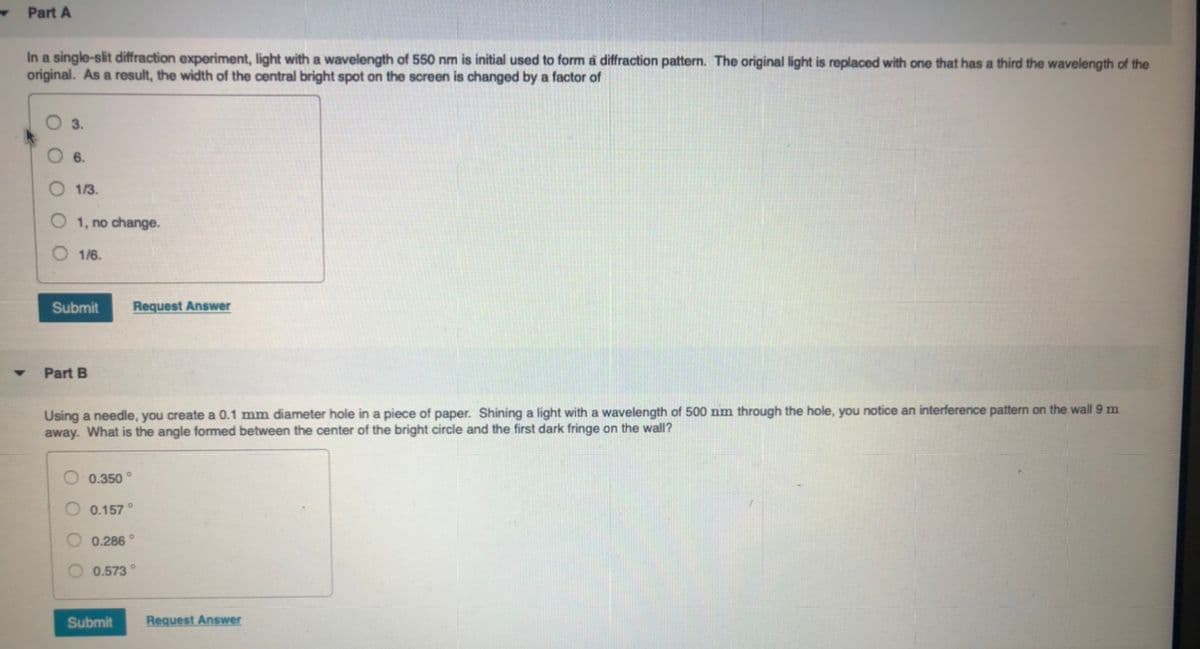Part A In a single-slit diffraction experiment, light with a wavelength of 550 nm is initial used to form a diffraction pattern. The original light is replaced with one that has a third the wavelen original. As a result, the width of the central bright spot on the screen is changed by a factor of
Part A In a single-slit diffraction experiment, light with a wavelength of 550 nm is initial used to form a diffraction pattern. The original light is replaced with one that has a third the wavelen original. As a result, the width of the central bright spot on the screen is changed by a factor of
University Physics Volume 3
17th Edition
ISBN:9781938168185
Author:William Moebs, Jeff Sanny
Publisher:William Moebs, Jeff Sanny
Chapter4: Diffraction
Section: Chapter Questions
Problem 34P: Two slits of width 2 m, each in an opaque material, are separated by a center-to-center distance of...
Related questions
Question

Transcribed Image Text:Part A
In a single-slit diffraction experiment, light with a wavelength of 550 nm is initial used to form a diffraction pattern. The original light is replaced with one that has a third the wavelength of the
original. As a result, the width of the central bright spot on the screen is changed by a factor of
O 3.
6.
1/3.
O1, no change.
O 1/6.
Submit
Request Answer
Part B
Using a needle, you create a 0.1 mm diameter hole in a piece of paper. Shining a light with a wavelength of 500 nm through the hole, you notice an interference pattern on the wall 9 m
away. What is the angle formed between the center of the bright circle and the first dark fringe on the wall?
O 0.350
O 0.157
O 0.286°
O 0.573
Submit
Request Answer
Expert Solution
This question has been solved!
Explore an expertly crafted, step-by-step solution for a thorough understanding of key concepts.
Step by step
Solved in 2 steps

Knowledge Booster
Learn more about
Need a deep-dive on the concept behind this application? Look no further. Learn more about this topic, physics and related others by exploring similar questions and additional content below.Recommended textbooks for you

University Physics Volume 3
Physics
ISBN:
9781938168185
Author:
William Moebs, Jeff Sanny
Publisher:
OpenStax

Principles of Physics: A Calculus-Based Text
Physics
ISBN:
9781133104261
Author:
Raymond A. Serway, John W. Jewett
Publisher:
Cengage Learning

Physics for Scientists and Engineers: Foundations…
Physics
ISBN:
9781133939146
Author:
Katz, Debora M.
Publisher:
Cengage Learning

University Physics Volume 3
Physics
ISBN:
9781938168185
Author:
William Moebs, Jeff Sanny
Publisher:
OpenStax

Principles of Physics: A Calculus-Based Text
Physics
ISBN:
9781133104261
Author:
Raymond A. Serway, John W. Jewett
Publisher:
Cengage Learning

Physics for Scientists and Engineers: Foundations…
Physics
ISBN:
9781133939146
Author:
Katz, Debora M.
Publisher:
Cengage Learning

Glencoe Physics: Principles and Problems, Student…
Physics
ISBN:
9780078807213
Author:
Paul W. Zitzewitz
Publisher:
Glencoe/McGraw-Hill